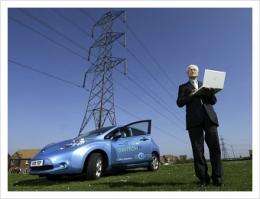Predicting an electric future

Experts at Northumbria University have developed a formula to predict the impact that electric cars will have on the nation’s power supplies.
Dr. Ghanim Putrus, Reader in Electrical Power Engineering in the School of Computing, Engineering and Information Sciences, led the project to create an easy-to-use tool to help policy makers prepare for an increase in electric vehicles and how the need to charge them will affect the national grid.
The ‘grid capacity calculator’ considers future electricity needs by taking a measurement of an area’s existing energy consumption and then calculating the likely future demand for, and impact of, having increasing numbers of electric cars plugged in for recharging.
The development of the new grid capacity calculator was a collaboration involving Northumbria University and Charge your Car project, a government programme which is currently installing electric vehicle charging points across North East England.
As the North East has been chosen as the UK’s first designated low carbon economic area (LCEA), there are plans to develop an infrastructure to support electric vehicles. Measures include the installation of 1,000 electric car charging points by 2013.
With the infrastructure in place it is expected that more people will switch from petrol or diesel cars to electric ones. These changes will mean that more people will be charging their cars and therefore creating an added pressure on the grid.
By allowing users to assess the impact of electric vehicles on an area’s grid in the presence of other low carbon technologies, the new tool will enable informed planning of the infrastructure for electric vehicles. The user-friendly tool is flexible and can be applied across all regions.
Dr. Putrus said: “The resource will help policy-makers, developers and network operators to analyze the impact of electric vehicles in the presence of micro generators and low carbon technologies. It will help to improve energy efficiency and reduce carbon emissions. This tool will help to build the infrastructure around electric cars and can be used inside and outside the region, as well as in international contexts.
“Any electricity usage scenario can be tested using this tool, giving a picture of what can happen to existing grid infrastructure and helping to plan future power networks or smart grids.”
The tool is the result of team work involving Dr. Sara Walker (School of the Built and Natural Environment), Dr. David Johnston and Mr. Edward Bentley (School of Computing, Engineering and Information Sciences). The team is currently discussing a follow up project with Charge your Car, which will develop the tool further to allow analysis of ‘smart charging’ of electric vehicles.
The team is also involved in a related European project (E-mobility NSR) addressing ‘smart grids solutions’ for future power networks and other joint projects on electrical vehicles with the School of Design.
These projects and other ongoing research will put Northumbria University at the forefront of research into a new generation of transport and the supporting infrastructure (smart grids).
Provided by Northumbria University





















